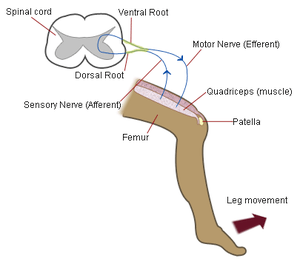Patellar reflex

The patellar reflex or knee-jerk is a deep tendon reflex and is a myotatic reflex.
Mechanism
Striking the patellar ligament with a reflex hammer just below the patella stretches the muscle spindle in the quadriceps muscle. This produces a signal which travels back to the spinal cord and synapses (without interneurons) at the level of L4 in the spinal cord, completely independent of higher centres. From there, an alpha-motor neuron conducts an efferent impulse back to the quadriceps femoris muscle, triggering contraction. This contraction, coordinated with the relaxation of the antagonistic flexor hamstring muscle causes the leg to kick. This reflex is a reflex of proprioception which helps maintain posture and balance, allowing to keep one's balance with little effort or conscious thought.
The patellar reflex is a clinical and classic example of the monosynaptic reflex arc. There is no interneuron in the pathway leading to contraction of the quadriceps muscle. Instead the bipolar sensory neuron synapses directly on a motor neuron in the spinal cord. However, there is an inhibitory interneuron used to relax the antagonistic hamstring muscle.
It tests L2, L3, and L4.[1]
Purpose of Testing
After the tap of a hammer, the leg is normally extended once and comes to rest. The absence or decrease of this reflex is problematic, and known as Westphal's sign. On the other hand, multiple oscillation of the leg following the tap may be a sign of a cerebellar disease. The test itself assesses the nervous tissue between and including the L2 and L4 segments.
History
The term knee-jerk was recorded by Sir Michael Foster in his Textbook of physiology in 1877: "Striking the tendon below the patella gives rise to a sudden extension of the leg, known as the knee-jerk."[2]
Popular culture
The term began to be used figuratively from the early 20th century onwards. O. O. McIntyre, in his New York Day-By-Day column in The Coshocton Tribune, October 1921, wrote: "Itinerant preacher stemming Broadway on a soap box. And gets only an occasional knee-jerk."[2]
See also
| Look up knee-jerk in Wiktionary, the free dictionary. |
Notes
- ↑ William J. Weiner (30 July 2010). Neurology for the Non-Neurologist. Lippincott Williams & Wilkins. pp. 499–. ISBN 978-1-60547-239-3. Retrieved 4 July 2011.
- ↑ 2.0 2.1 Knee-jerk reaction
References
- Gurfinkel' VS, Lipshits MI, Popov KE (1974). "Is the stretch reflex a basic mechanism in the system of regulation of human vertical posture?". Biofizika (in Russian) 19 (4): 744–8. PMID 4425696.
- Pinnock CA, Lin ES, Smith T (2003). "9". Fundamentals of Anaesthesia, 2nd Edition (2 ed.). Greenwich Medical Media Ltd.
| |||||||||||||||||||||||||||||||||||||